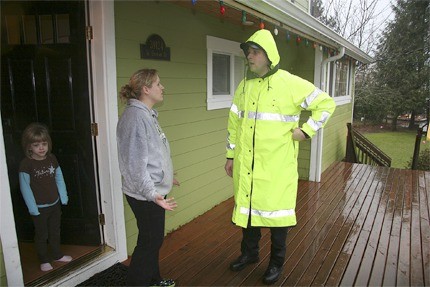Years of enduring flooding, and rebuilding, are etched in Snoqualmie’s downtown neighborhood.
Residents who’ve been here more than a few years can point to the lines on the wall that mark high water. Locals anticipate the areas that flood first. And the city firefighters have the warning system down to a science.
“We know floods,” says Snoqualmie Fire Chief Bob Rowe. “That’s one thing Snoqualmie is known for.”
So when the river monitoring stations uphill say that the river is rising enough for flooding, firefighters go into action. The city sends out reverse-911 calls, messaging residents in areas that will get wet. Later, firefighters will go door to door, asking people to flee. If they don’t go, they can get trapped.
In Snoqualmie, typically the worst-hit Valley city, it starts with Pickering Court, downtown. Then, neighborhoods by the river, at Meadowbrook, and near Kimball Creek start to flood. A big one can swamp most of the downtown area.
Emergency officials’ major concern, every time, is safety. So when the word to evacuate comes, Rowe asks that locals take heed.
Many lowland residents have already raised their homes.
“That’ll protect the house,” said Rowe. “If they decide to stay in their house, they might be dry, and no problems. But what if they have a medical emergency? Or the power goes out and they start getting cold? I have to put my rescuers in harm’s way,” sending the city’s swiftwater team through cold, treacherous hazards to save someone who should have heeded the warning.
The winter of 2013-14 is expected to be another neutral year in the El Niño/La Niña weather cycle. Neutral years can sometimes bring major weather events and floods.
In the Valley, the 2006 neutral winter brought a windstorm that knocked out power in the Valley for a week or more, followed by the second worst flood on record. The 1990 flood, considered the worst ever, was also a neutral year.
“We can get a good snowpack and have a ‘Pineapple Express,’” a burst of warm weather that melts all that snow, said Rowe. “That’s what caused the severe flooding in 1990.”
Snoqualmie isn’t the only Valley city that floods.
Low-lying areas of North Bend can and do get inundated. In the 2009 flood, inches of water covered the grounds of the Mount Si Senior Center, downtown.
Medium floods can wash over the lowland golf courses at Fall City, and a big one can cover Highway 202 between Snoqualmie Falls and the Fall City roundabout.
Residential flooding is rare in the vicinity of Carnation. But when a major flood hits, it can isolate the city. The roads that cross the Valley, including Highway 203 south and north of the city, go under. But the town itself rarely floods.
Putting the Valley back together, responders usually start by restoring power.
“The communities usually try to get schools back in session as quickly as possible,” said Rowe. That brings a sense of normalcy. “Then, (we) get the business back up and running so people can get their supplies and then clean up.”
Rowe is hosting a meeting with partner agencies, including EFR, the Snoqualmie Valley School District, Snoqualmie Valley Hospital and local public works staff, on October 30
The idea is to put a community-wide plan in place, and establish contacts.
“We may be isolated,” Rowe said. “We need to work together to make sure our communities’ needs are being met.
One particular concern this year is how residents outside the cities can get around safely in snowstorms, due to cuts by the county roads division.
Thinking ahead
Josie Williams, a former Fall City resident and spokeswoman for Eastside Fire and Rescue, went nine days without power in the 2006 storm.
“Every day, we had to get gas for the generator,” she recalls.
When a disaster happens, it’s often too late to stock up. When Williams went to the supermarket during the 2006 outage, she noticed that essentials like candles were often sold out.
“You’re competing with everybody else during these times,” she says. You can save yourself a lot of trouble by planning and shopping early. It’s important to store extra water, food, flashlights and other essentials well ahead of time.
It’s easy to be overwhelmed by the scale of a disaster, and the need to react. Some thinking ahead of time is well worth it.
“Think about what you’re going to need on a camping trip,” Williams advises. “These are the kinds of things you have to fall back on.”
“The biggest issue is the attitude that ‘it won’t happen to me,’” Rowe said. “People say it only happens in faraway places. It doesn’t happen to my family.” But the reality is that disasters do happen here.
Planning, getting a kit ready, gathering supplies are vital to being ready for the possible.
“Plan to let each other know you’re safe and where you’re at,” Rowe said.
A warm coat, a good set of shoes and a list of medication is a good starting point. After 2012’s multiple-day power-outage, EFR stresses the need to be careful about carbon monoxide. If people are using kerosene heaters or stoves, they need to ensure they are used in well-ventilated areas.
EFR is concerned that people who keep extra gasoline may end up inadvertently creating fire dangers.
The same warning goes for families who rely on candles during outages. If you need to leave the room, put out the candle; don’t leave it burning unattended, as that could lead to a fire.
Both the cities of North Bend and Snoqualmie broadcast travel restrictions on the local emergency radio channel, AM 1650.
• You can find education and preparedness information and classes at http://www.ci.snoqualmie.wa.us/CityDepartments/Fire/EducationPreparedness.aspx.



